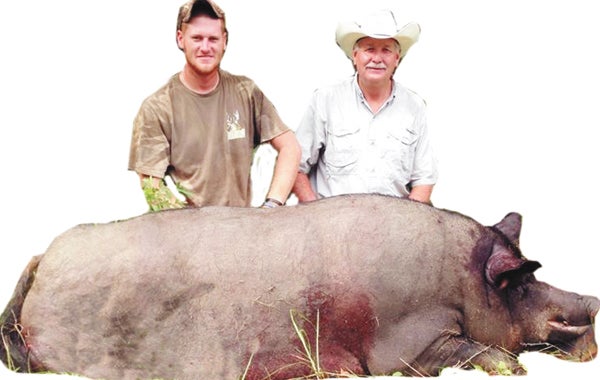THAT’S A RAZORBACK
Published 12:00 am Thursday, July 17, 2014

Nathan Shirey is shown with property owner Terry Moody with the more than 400-pound feral hog that he and friends killed near Luverne this weekend.
A group of friends from Covington County bagged a huge prize while hog hunting near Luverne over the weekend when they killed a feral pig weighing more than 400 pounds. And their hunting success is something local experts say is a good thing for the area’s ecosystem.
Mark Hainds, a biologist by trade, works as a restoration coordinator for the Longleaf Alliance and in 2011 penned a book, “Year of the Pig,” about feral hogs. Hainds said when Nathan Shirey, John “Opie” Dauphin, Ashley Barnes and Taylor Blackburn killed the massive hog, they were helping eliminate one of the biggest threats to Alabama’s ecosystem.
“They are not native to the western hemisphere,” Hainds said of feral pigs. “They likely came over with (Spanish explorer Hernando) De Soto. So, everything we have native evolved without predation from feral pigs. They are omnivores, so they eat just about anything, but rooting is where we see most of their destruction. They’re also really harmful to our native flora and they are severe predators on frogs, salamanders and snakes.”
And, while Hainds said the Longleaf Alliance has been able to nearly squelch the feral pig population in some parts of the county, in others he said it is once again on the rise.
“There are large parts of the state where the population is expanding very rapidly,” Hainds said. “We had very high populations for five-to-six years around where I work, which is the western edge of Covington County going toward Brewton. We basically have eliminated most of them. We killed about 100 a year within five-mile radius. We haven’t seen a pig around there for about three years.”
But in the northern part of Covington County, Hainds said that is not the case, a statistic reflected in local hog hunting laws.
“It is considered ecological hunting if you’re out trying to reduce or eliminate the population,” he said. “You’ve got some people that are trying to manage the population so they’ll have something to hunt. Now, you can shoot hogs 365 days a year. You can also shoot at night, which is unlike hunting deer. There is no limit on how many you can kill and virtually any legal weapon can be used.”
In this area, Hainds said hog-hunting using tracking dogs is very popular. Hainds added that, for those worried about the large animals’ nature or killing something that kills snakes, neither factor is a real issue.
“They are not going to be a control mechanism on snakes and they usually eat slower moving amphibians like salamander anyway,” Hainds said.
As for whether or not they are a danger to humans, Hainds said not normally.
“The most dangerous pig is a domestic sow with piglets, because she has no fear of humans and she’s very protective,” he said. “If you give a feral pig an avenue to escape, 99 out of 100 times it will take it.”





